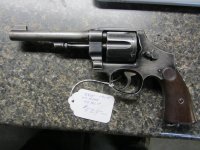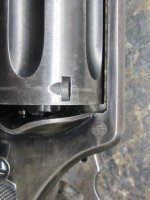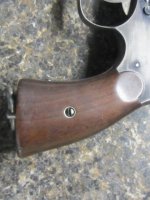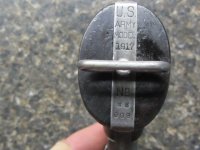I agree with Muley Gil. Based on your description and if it's original and not converted to 45 Colt or other parts changed/replaced, $500 is about right. More decent original finish and unmodified gun can go to $7-800. A 95% plus gun will go up from there, especially with a very low s/n.
Here's what to look for:
SERIAL # LOCATIONS: To confirm all parts are original, one can check for the 6 matching serial # locations for fixed sight pre war Hand Ejectors and all post war Hand Ejectors thru ~1956 and a few as much as 3 years later.
NOTE: Observing serial #s for accuracy or even existence, especially on penciled stocks, requires magnification, bright light, and an attitude that it is there!
1. Gun butt - or fore strap on I frames/single shots with grips that cover the butt
2. Barrel - bottom of barrel or in extractor shroud
3. Yoke - on rear face only visible thru a chamber with a flashlight
4. Extractor star - backside
5. Cylinder - rear face
6. Right stock only - on back; stamped, scratched or penciled depending on vintage and stock material. (except most post war target grips because individual fitting not required.)
1917 PRODUCTION SUMMARY:
Military 1917s are in the range #1 thru # 169959 with 163,635 revolvers completed and delivered by or in 1918, and approximately 7,300 revolvers were delivered partially completed and were not counted in the 163,635 figure. As usual with S&W, revolvers were not completed in order of their serial numbers and all numbers were not used. All were shipped to Springfield Armory.
Both S&W (7300 frames) and Colt were allowed to purchase M1917 revolvers left over when their rebuild contracts were terminated at the end of WWII.* (Pate, see below for full text.)
Most early WWI 1917s are marked "GHS" in a circle, (Gilbert H. Stewart), Gov’t inspector, left side frame up near the hammer serial number range 1-42000. There’s also a GHD Guy H. Drewry inspector from 1930-1957 (with various increasing ranks in front of his name), who was in charge of the Hartford Ordnance District and under whose authority and name, ordnance contractors stationed at the S&W factory inspected guns both for Lend-lease and for ASP (Army Supply Program) contracts.
Middle range guns are marked with a flaming bomb, beginning c. #42000 to April 1918.
Late war time produced guns are marked in various locations with an eagle head over an "S" followed by a number like S1, S2, S3, S4, S6, S9, S24, S27, S34, etc., from April 1918 to war’s end. These marks are inspector marks used on Military guns which are also marked "United States Property” on the underside of the barrel.
The butt of the gun will have a two line serial number (when over 3 digits) and U.S. Army Model 1917 in four lines as well as a lanyard ring (which is the earliest version; polished and case colored, not sandblasted and blued). “UNITED STATES PROPERTY” is roll stamped under the front end of the barrel.
Earliest have smooth, concave round top stocks and circular hammer grooves up to about #15,000. Although, many have been observed sporadically up to the #20,000 range. As with all things S&W, there is seldom a specific serial number cut off. Deletion of the stocks w/concave top and the hammer grooves were of the earliest changes.
Most 1917 military issue have round top straps and a U notch rear sight. Later built frames with early #s have been observed with flat top strap and square notch rear sight; example #113934. It is not known when this change was initiated. However, cumulative wisdom is that the flat-top strap with Sq notch rear sight revision came to the N-frame in the 1926/1927 time frame.
War time 1917s did not have S&W trademark logos nor even commercial models (nor did any hand ejectors following the war until ~ 1920).
ARSENAL REBUILD: If there’s an extra large stamped # up to 5 digits (sometimes with an R or S) in the yoke, yoke cut out, under the barrel, or all three places, it’s an arsenal # indicating an arsenal rebuilt gun. The R may be found on the frame left side as well. Examples:
Tryig to identify 1917 Revolver &
http://smith-wessonforum.com/s-w-ha...-my-1917-hand-ejector-45-a.html#post139209650
“WW I U.S. 1917 hammers and triggers are slightly different from later N frame parts.” Lee Jarrett.
And will work in triple locks.
Cylinder hold open detent:
In my experience military 1917s had the cylinder hold open detent in the yoke bell crank as did all pre war N frames and some early I and K frames. The cyl hold open detent went away on all frames after WW II with the usual few exceptions that had frames/yokes made pre war. It's been reported that some 1917s do not have the detent as a war time expedient, but of the hundreds of 1917s I've seen all did or at least had the hole with wear evidence that the detent spring and pin were lost. Use caution if you remove the yoke and cylinder from the frame or the spring and plunger can launch across the room.
Plunger shown here in bottom of yoke and has a spring underneath it:
S&W Assembly (factory work) #s: These multi-digit numbers of 3 to 5 digits, are on the yoke at the hinge, in the ‘yoke cut’ on frame opposite the yoke, and inside of the sideplate, for the pre war and post war period to ~1958.
FEATURES:
5-1/2" in cal 45 ACP, but the barrel reads "S.&W. D.A. 45".
Shiny Blue like shown below.
Butt Swivel.
No logo on either side of frame.
Smooth walnut stocks, no medallions.
Pre ~ 40,000 s/n flaming bomb inspector stamp and Pre ~ 20,000 s/n
grooved hammer. later hammers are smooth:











